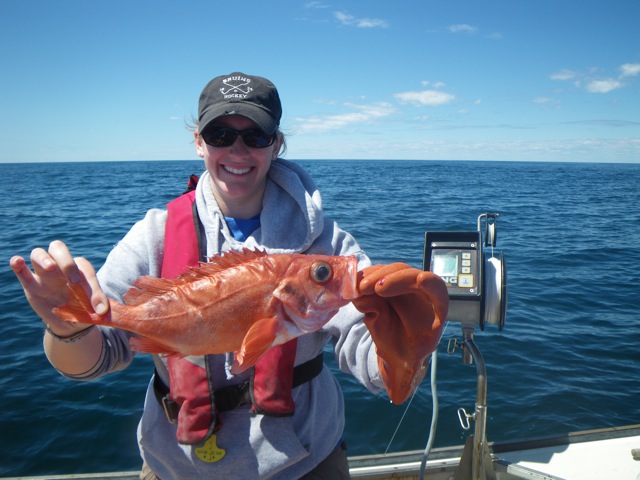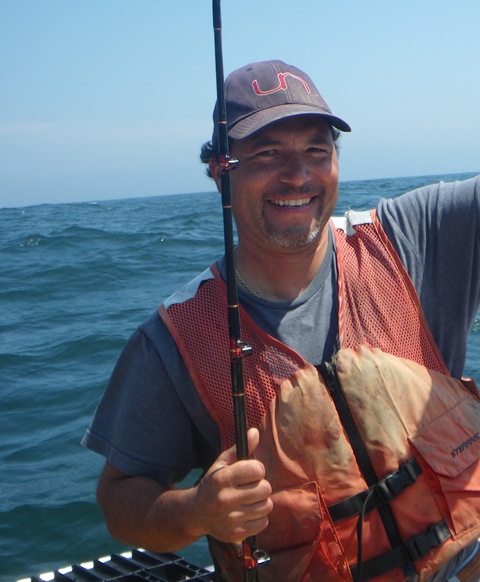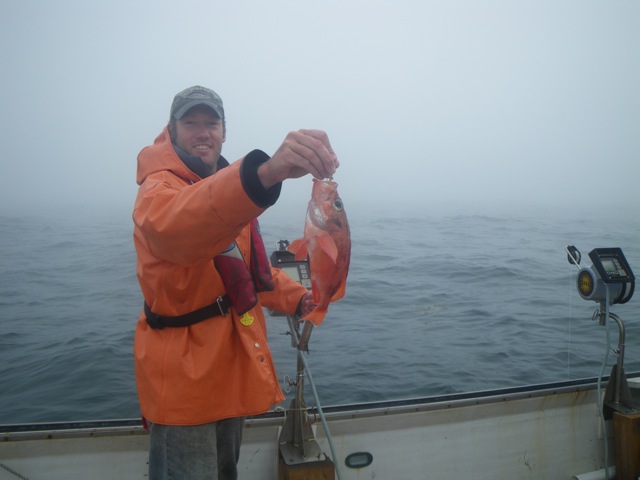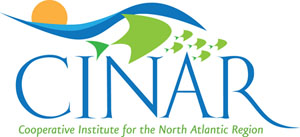Redfish, like several Gulf of Maine fisheries, was once heavily targeted and fell to all-time low stock abundances in the mid-1980s. However, through a series of time and area closures, fishing gear restrictions, minimum fish size limits, formal rebuilding plans, and other measures by the New England Fishery Management Council (at significant sacrifice to fishermen), redfish is now considered a fully rebuilt stock. The only problem is, where is the fishery?
The regulations precluded a significant redfish fishery in the New England region for almost two decades, and even though the fish are now back, the fishery has not rebounded so quickly. A reinvigorated redfish fishery could provide an economic boost to coastal economies that once relied on this resource.

GMRI intern Kristen Garabedian with a redfish caught with the jig in the background aboard F/V Andanamra. Photo by Adam Baukus, Gulf of Maine Research Institute.
On November 4, 2010, a symposium will be held in Danvers, Massachusetts to bring fishermen, managers, and scientists together to discuss the historical and current status of redfish populations and the fishery, and share ideas on sustainable redfish harvesting technologies and marketing opportunities. Regional stakeholders and international experts will share their experiences and explore how this traditional New England fishery can be harvested in an ecologically and economically sustainable manner.
“We hope by coordinating this meeting, the fishing industry can get ahead of the curve,” says symposium convener Dr. Ken La Valley of New Hampshire Sea Grant and University of New Hampshire Cooperative Extension. “We’ll gain insight into what gear modifications may lead to more selective fishing for redfish, and discuss the implications of a directed fishery, both biological and economic.”
The redfish fishery was harvested up into the 1980s almost exclusively by large otter trawl vessels (>150 gross registered tons) using relatively small mesh nets. A series of regulatory changes progressively increased the minimum mesh size from 70 mm (about 3 in.) up to 152 mm (about 6¼ in.) by 1994 in order to reduce bycatch of juvenile redfish and non-target species. The low biomass, combined with the mesh restriction, served to effectively eliminate the fishery.1

Captain Jason Joyce of the F/V Andanamra. Photo by Adam Baukus, Gulf of Maine Research Institute.
Today, managers have allocated more redfish for fishing than the industry is taking advantage of. There are some otter trawl vessels perusing the fishery again,2 but with an ex-vessel price of less than $1 per pound, fishermen are interested in exploring alternative redfish harvesting technologies.
Recently, commercial fisherman Jason Joyce of Swan’s Island, Maine teamed up with Gulf of Maine Research Institute scientists Adam Baukus and Steve Eayrs and intern Kristen Garabedian to evaluate how practical and economically viable harvesting redfish using jigging machines would be. Jigging can be a highly selective and low-cost fishing method. With Northeast Consortium-funded project development award funding, the team conducted ten days of collaborative research between July and September 2010 on the F/V Andanamra, all within a day’s steam of Swan’s Island. They used sonar and tub trawls to find fish, then tested different jigging methods and hook sizes to optimize for catching redfish.
Though the researchers sampled numerous locations throughout downeast Maine, few fish were found. While the machines did not catch large numbers of fish on these trips they were easy to install on the boat, and jigging was easy to integrate with other fishing methods (i.e. jig in between setting and hauling of tub trawl) . Additionally, Baukus is surveying about 30 local restaurants to determine interest in serving redfish and some of the obstacles to be overcome in reinvigorating local markets.

Researcher Adam Baukus shows a redfish caught on automatic jigging machines. Photo by Kristen Garabedian, Gulf of Maine Research Institute.
Baukus reports that, “more research is needed to find reliable sources of fish in the downeast Maine region, however the machines have proven to be quite versatile and could be used as a primary gear type, or in addition to other gear. We have seen interest in redfish from both the fishermen and marketing communities, though both sides of the operation need more information before they can pick up momentum.”
This research project will be one of several highlighted at the symposium.
For more information about the 2010 Northeast Regional Redfish Symposium and to register, visit http://tinyurl.com/redfish2010. The meeting is open to the public and is being coordinated by New Hampshire Sea Grant, the Northeast Consortium, Massachusetts Division of Marine Fisheries, University of Massachusetts, the Northeast Fishery Science Center, and a commercial fisherman.
1 http://www.nefsc.noaa.gov/sos/spsyn/pg/redfish/ acceded October 2010.
2 Prybot, 2010. ME Boats go for redfish the new-fashioned way. Commercial Fisheries News, September, p. 20.
Rachel Feeney is the Communications and Information Coordinator for the Northeast Consortium, a collaborative research funding program founded in 1999 and based at the University of New Hampshire. www.northeastconsortium.org
Print


















